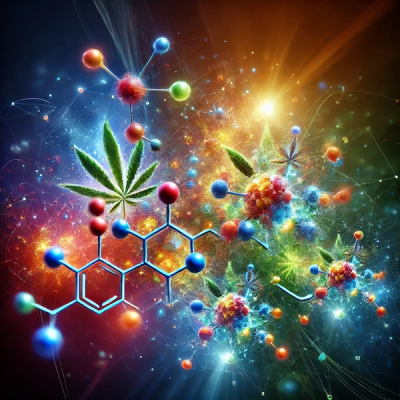Cannabimimetics - The most effective alternative to CBD
Author: Ondre Stovicek
You have probably heard of compounds in cannabis such as CBD, CBG, CBN, THC. But what about cannabimimetics? Struggling to even read this word? No matter your initial opinion on this somewhat clumsy name, we definitely recommend reading this article carefully, as it will give you an insight into cannabimimetics. Specifically, what these substances are and how they affect the human body. And we promise, you won’t regret it!
What are Cannabimimetics?
Cannabimimetics are substances that have the same effects as phytocannabinoids (THC, CBD) or endocannabinoids (Anandamide (AEA) – known as the molecule of bliss, 2-arachidonoylglycerol (2-AG) – affects key processes such as immunity and the nervous system), substances naturally occurring in the human body that influence the endocannabinoid system (ECS) by acting on CB1 receptors.
In other words, they are substances that are agonists (influencers) of cannabinoid receptor type 1 - CB1 receptors.
Where can we find Cannabimimetics?
In nature (plants and herbs)
Some plants contain compounds that mimic the effects of cannabinoids by influencing the endocannabinoid system (ECS). Examples of these plants include:
- Black pepper (Piper nigrum) – contains beta-caryophyllene, which binds to CB2 receptors.
- Echinacea – contains alkylamides that affect the ECS.
- Kava-kava (Piper methysticum) – contains substances that influence the ECS and relaxation processes.
- Rosemary and cloves – contain terpenes that can modulate the ECS.
- Cocoa – contains compounds that increase the level of anandamide, a natural endocannabinoid.
- Flaxseeds – contain lignans that modulate the ECS.
In synthetic form
- Synthetic cannabinoids: Chemically created substances used in medicine, such as Nabilone or Dronabinol, which are often prescribed for pain, nausea, or inflammation.
- Experimental substances: Used in research to study the ECS and explore new therapeutic possibilities.
In foods and spices
In addition to cocoa, cannabinoid-like substances are found in some common foods, such as:
- Flaxseeds – contain lignans that interact with the ECS.
- Beer – due to the presence of hop terpenes.
How do Cannabimimetics work?
They interact with cannabinoid receptors (CB1) in the body, which are part of the ECS.
They mimic the effects of natural endocannabinoids, substances the body produces itself.
They can influence processes such as:
- Pain regulation
- Immune response
- Inflammation
- Mood and stress
- Appetite
Uses of Cannabimimetics
Medicine and health
- Pain management – Used for relieving chronic and neuropathic pain, similar to cannabinoids.
- Inflammation and autoimmune diseases – Due to their anti-inflammatory properties, they can help with rheumatoid arthritis, Crohn’s disease, or psoriasis.
- Mental health – Help with stress, anxiety, depression, and post-traumatic stress disorder (PTSD).
- Neurological disorders – Beneficial for conditions such as Parkinson's disease, Alzheimer's disease, epilepsy, or multiple sclerosis.
- Sleep support – Used for insomnia and disrupted sleep cycles.
Prevention
- Immune support – Help regulate immune responses, which can be useful during seasonal illnesses.
- Stress reduction and relaxation – Some natural sources of cannabimimetics (e.g., kava-kava or terpenes) promote calmness and well-being.
- Regeneration and sports – Support faster muscle recovery and reduce inflammation in athletes.
Nutrition and dietary supplements
- Flaxseeds – and other foods rich in lignans support gut health and hormonal balance.
- Terpenes and flavonoids – Added to beverages, teas, or oils to enhance their health benefits.
- Digestive supplements – Beta-caryophyllene from black pepper or rosemary supports healthy digestion.
Veterinary medicine
Cannabimimetics are increasingly used in veterinary practice:
- Animal health support – For dogs and cats in treating anxiety, pain, inflammation, or skin problems.
- Livestock nutrition – Adding to animal feed can improve the health and condition of animals, such as horses or cattle.
Cosmetics
Cannabimimetics are used in the cosmetic industry for their anti-inflammatory and regenerative properties:
- Skin treatments – Help with acne, eczema, or skin irritation.
- Anti-aging – Flavonoids and polyphenols act as antioxidants to protect the skin from aging.
- Hair regeneration – Supports the health of hair and the scalp.
Cannabimimetics vs. CBD (Cannabidiol)
Now, the very important question arises: what is the difference between CBD and cannabimimetics? Both affect the endocannabinoid system, but they have different properties, origins, and mechanisms of action.
Origin
Cannabimimetics, unlike CBD, do not have to come from the cannabis plant, making them a versatile option.
Mechanism of action
Cannabimimetics bind to cannabinoid receptors (CB1, CB2), modulate endocannabinoid levels, and support related receptors (e.g., TRPV1). Cannabinoids (CBD) do not act directly on CB1 and CB2 receptors and modulate the ECS more indirectly. They activate other receptors (e.g., TRPV1).
Effects
The effect of cannabimimetics depends on the specific substance. However, they generally mimic the effects of natural cannabinoids. You can expect them to have anti-inflammatory, analgesic, and relaxing effects.
For example, beta-caryophyllene acts as a selective CB2 agonist, useful in reducing inflammation.
CBD has a much broader range of effects (and is better studied).
Cannabimimetics are being researched mainly for their potential health benefits for the human body, as well as their easy accessibility (they provide a solution for countries where cannabis is strictly regulated). They offer new possibilities in treatment, prevention, and health support, while also deepening our understanding of how the human body functions.


